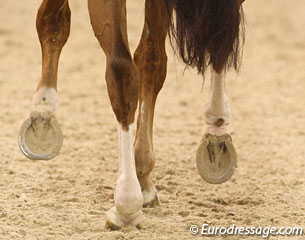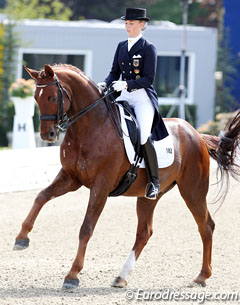
On 6 April 2011 FEI Dressage Judge General Ghislain Fouarge issued the following judging guidelines for the evaluation of piaffe, transitions and the walk. In his memo he requests to be more strict when mistakes to the correct execution of a movement are made
, but also to be more generous when certain movements are executed with clarity and effortlessness.
Read Mr Fouarge's guidelines here:
Marking of mistakes
When evaluating a piaffe where there are mistakes, irregularities or interruptions of any kind, it is clearly only the mark for the piaffe itself that will be affected and the horse will be punished only once for the mistakes made. However when the mistake spills over into the transition and affects the passage it is not sufficient to punish only once as all three elements are affected.
Example: Horse in the piaffe breaks into canter, canters out of the movement and does not show passage over the designated distance. To punish only once would clearly be insufficient as the transition mark is also affected by no transition out and the mark for passage would be affected by showing too little.
In such a case the horse must be punished 3 times. Once for the piaffe, once for the transition and once for the passage. Anything else would be unfair to those who show only one mistake in one element. If however the horse is corrected in the piaffe and is able to make the transition out to passage only the piaffe mark is affected
Currently we apply this principle to the marking of mistakes in the extended canter/collected canter and flying change. If the rider does not correct the horse when changing in the extension and therefore makes no clear transition and flying change on the aid we penalize the horse in both elements of the movement. Obviously the Grand Prix Special is different where both elements are included in one mark.
Evaluation of the piaffe
Nowadays we are not strict enough when evaluating the piaffe, especially when there are irregularities.
Example: If a walk looses correct rhythm it is immediately punished with a mark below 5. If a horse changes behind in a canter pirouette the mark comes down to a 4 because of the irregularity. This principle should also apply to the piaffe.
Faults in the rhythm are as follows:
- not diagonal
- double beats
- long, short or all time unlevel steps
 In all these cases the mark must be below 5 because of the irregularity. It is clear, if the horse falls in walk or canter, it cannot be more than 3.
In all these cases the mark must be below 5 because of the irregularity. It is clear, if the horse falls in walk or canter, it cannot be more than 3.
Other faults are as follows:
- Going more than 1 meter forward. This is only half steps not piaffe, therefore not more than 5.
- Slight backward tendency – 5 or less depending on severity.
- Crossing behind or in front therefore unbalanced can be a 6 when slight but lower when more extreme
- High croup not taking weight behind cannot be a high mark, then the horse is coming clearly on the forehand
- Base wide or over-closing cannot be a high mark
Not enough steps: The quality of piaffe has an influence when 10/11 steps are shown, but then the marks have to go down when less than 10 steps are shown, 8/9 steps the marks should go lower for 1 further mark, 7/8 steps 2 further marks lower, but when only 5/6 steps are shown no doubt is 3 and reflection on transition.
Evaluation of the walk
When the walk is not a clear 4 beat rhythm the mark is not more than 5.
When not regular (sometimes due to tension) not more than 4.
When clearly lateral maximum 3
When both extended and collected walks shown are irregular, the mark for paces cannot be higher than 6.
When the collected walk is only affected, then it is not a problem as the former, but means that the horse is not yet prepared for that degree of collection.
This is not included in the marks for the paces but rather in the 3rd collective mark. (what is usually named submission, but which in fact means amongst other COLLECTION)
Areas where we can be more positive and the results could be a higher mark as 8 and more
When judging there are many instances where certain movements are marked in accordance with the average of the test which is not necessarily correct. There are also cases where some movements receive less consideration than the major elements according to the level of the test.
Some examples :
- The flying change between the pirouettes is mainly scored 6 or 7. but if they are straight, uphill and fluent the marks should be higher.
- The collected walk between the pirouettes is seldom given more than 7,but if the rhythm is clear, good engaged and in a good collection, we should go higher .
- The transition from walk to passage. If the transition is direct and prompt, why not 8 or more.
- This is the same in the transitions passage – extended trot – passage, if they are showed in a supple way, without restriction.
- Also in the case in the transition from the collected canter to trot, if this is performed fluent , and the trot is immediately showed in a good collection
- The transition from passage into canter, if the transition is direct, followed by high quality canter also 8 or more
- Another example is the flying change at the end of the pirouette in Inter 1 , if clear uphill , straight and fluent
 In all these instances the tendency is towards the 6 or 7 whereas in the major elements we are more inclined to go higher and lower. This is not entirely fair and these movements should be given more thought to achieve a better end result for the riders.
In all these instances the tendency is towards the 6 or 7 whereas in the major elements we are more inclined to go higher and lower. This is not entirely fair and these movements should be given more thought to achieve a better end result for the riders.
Example: Even if the pirouettes are only satisfactory the flying change may have the quality and straightness for an 8 or 9 and this should be awarded. Likewise when seemingly simple transition from canter to trot in the Grand Prix is done in a very good way it should be marked up even if the horse’s average scores are closer to 6 or 7.
It is clear that judges should evaluate all the criteria in a balanced and clear way. Good, very good and excellent can apply to all the elements of each test not just the parts where the level of expression and extra ability bring high marks very easily. It is sometimes the lesser movements and transitions that form the vital link between the major movements of the test and show the real quality of training according to the Training Scale
-- by Ghislain Fouarge
Related Links
Judging Panel for 2011 European Dressage Championships Announced
Fouarge Elected First FEI Dressage Judge General
In the Firing Line: The Dressage System of Judging